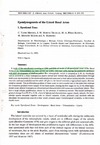Identificador persistente para citar o vincular este elemento:
https://accedacris.ulpgc.es/jspui/handle/10553/74817
| Campo DC | Valor | idioma |
|---|---|---|
| dc.contributor.author | Yanes Mendez, C. | en_US |
| dc.contributor.author | Martín Trujillo, J. M. | en_US |
| dc.contributor.author | Pérez Batista, M. A. | en_US |
| dc.contributor.author | Monzón Mayor, Maximina | en_US |
| dc.contributor.author | Martínez Marrero, Antonio | en_US |
| dc.date.accessioned | 2020-10-16T15:52:47Z | - |
| dc.date.available | 2020-10-16T15:52:47Z | - |
| dc.date.issued | 1988 | en_US |
| dc.identifier.issn | 0044-3107 | en_US |
| dc.identifier.other | WoS | - |
| dc.identifier.uri | https://accedacris.ulpgc.es/handle/10553/74817 | - |
| dc.description.abstract | A study of the ependymary covering at (OM and EM) all levels of all ependymal zones of the Basal Areas of the Telencephalon has been caried out [vz(b), vz(e) and vz(f)], during the embryonic, postnatal and adult development of Gallotia galloti. The telencephalic vesicle is iniciated at E-30, its ventricular wall is covered by a thick hoogenous matrix (dorsal and ventral) that gradually differentiates through embryonic development in the mentioned ependymal zones and in four sulcus (sulcus lateralis, terminalis, ventralis and septomedialis) and the adult will give to the lateral ventricle a regionalized aspect, denominated as mosaic. | en_US |
| dc.language | eng | en_US |
| dc.relation.ispartof | Zeitschrift fuer Mikroskopisch-Anatomische Forschung | en_US |
| dc.source | Zeitschrift fuer Mikroskopisch-Anatomische Forschung [ISSN 0044-3107], v. 102 (4), p. 555-572, (1988) | en_US |
| dc.subject | 320103 Microbiología clínica | en_US |
| dc.subject.other | Ependymal Zones | en_US |
| dc.subject.other | Development | en_US |
| dc.subject.other | Basal Areas | en_US |
| dc.subject.other | Telencephalon | en_US |
| dc.subject.other | Lizard | en_US |
| dc.title | Ependymogenesis of the Lizard Basal Areas1. Ependymal Zones | en_US |
| dc.type | info:eu-repo/semantics/Article | en_US |
| dc.type | Article | en_US |
| dc.identifier.isi | A1988P581100004 | - |
| dc.description.lastpage | 572 | en_US |
| dc.identifier.issue | 4 | - |
| dc.description.firstpage | 555 | en_US |
| dc.relation.volume | 102 | en_US |
| dc.investigacion | Ciencias de la Salud | en_US |
| dc.type2 | Artículo | en_US |
| dc.contributor.daisngid | 2042224 | - |
| dc.contributor.daisngid | 1530540 | - |
| dc.contributor.daisngid | 4119642 | - |
| dc.contributor.daisngid | 15494539 | - |
| dc.contributor.daisngid | 10179849 | - |
| dc.description.numberofpages | 18 | en_US |
| dc.utils.revision | Sí | en_US |
| dc.contributor.wosstandard | WOS:MENDEZ, CY | - |
| dc.contributor.wosstandard | WOS:TRUJILLO, JMM | - |
| dc.contributor.wosstandard | WOS:BATISTA, MAP | - |
| dc.contributor.wosstandard | WOS:MAYOR, MM | - |
| dc.contributor.wosstandard | WOS:MARRERO, A | - |
| dc.date.coverdate | 1988 | en_US |
| dc.identifier.ulpgc | Sí | es |
| item.fulltext | Con texto completo | - |
| item.grantfulltext | open | - |
| crisitem.author.dept | GIR IUIBS: Tecnología Médica y Audiovisual | - |
| crisitem.author.dept | IU de Investigaciones Biomédicas y Sanitarias | - |
| crisitem.author.dept | GIR IOCAG: Oceanografía Física | - |
| crisitem.author.dept | IU de Oceanografía y Cambio Global | - |
| crisitem.author.dept | Departamento de Física | - |
| crisitem.author.orcid | 0000-0002-5046-508X | - |
| crisitem.author.orcid | 0000-0002-2376-1561 | - |
| crisitem.author.parentorg | IU de Investigaciones Biomédicas y Sanitarias | - |
| crisitem.author.parentorg | IU de Oceanografía y Cambio Global | - |
| crisitem.author.fullName | Monzón Mayor,Maximina | - |
| crisitem.author.fullName | Martínez Marrero, Antonio | - |
| Colección: | Artículos | |
Citas de WEB OF SCIENCETM
Citations
8
actualizado el 25-feb-2024
Visitas
160
actualizado el 15-mar-2025
Descargas
191
actualizado el 15-mar-2025
Google ScholarTM
Verifica
Comparte
Exporta metadatos
Los elementos en ULPGC accedaCRIS están protegidos por derechos de autor con todos los derechos reservados, a menos que se indique lo contrario.
